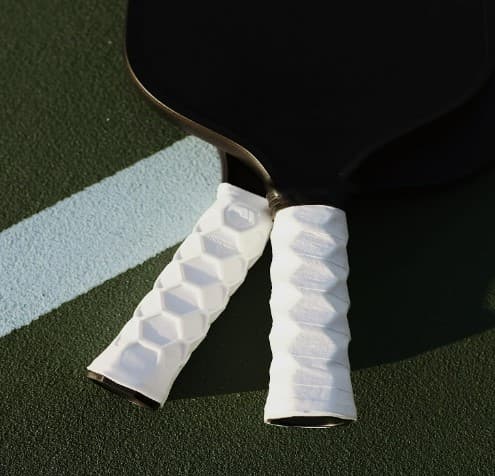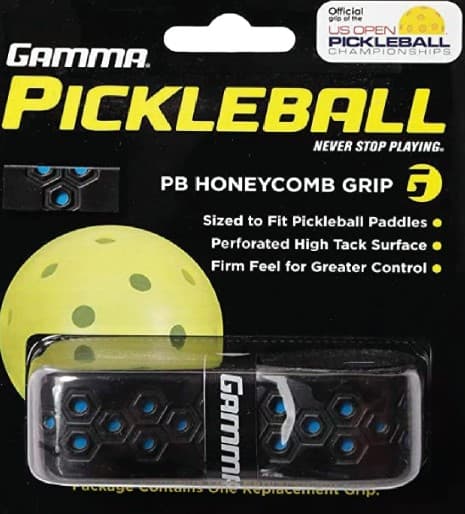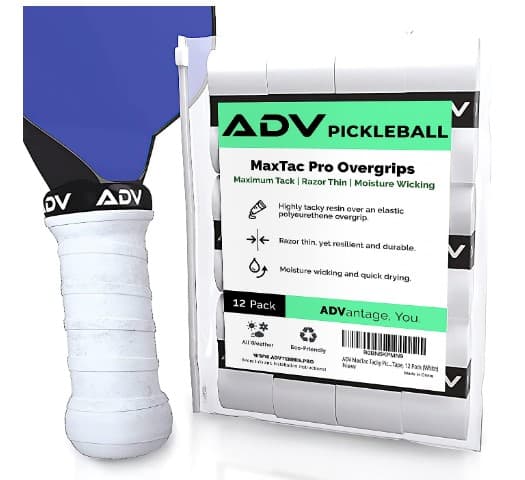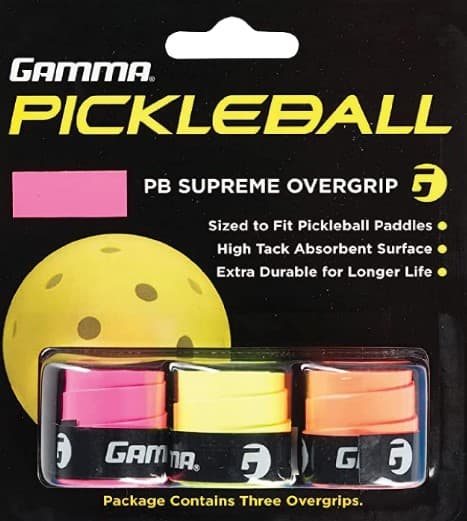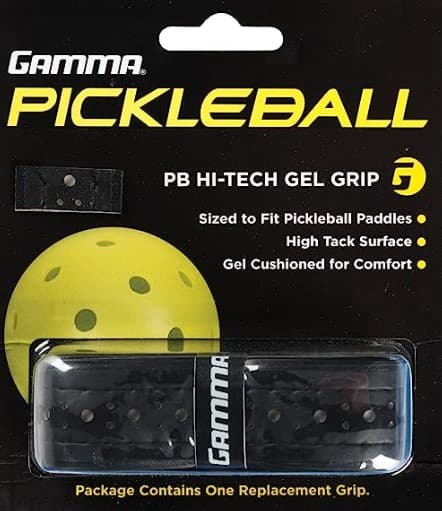Pickleball Paddle Grip
Unlike other racket sports, pickleball has created its own unique set of rules and specialized equipment, including paddles made of wood or composite materials. One important piece of equipment that pickleball players need to pay attention to is the grip on their paddle.
The grip plays an essential role in how players hold the paddle, control their shots, and perform on the court. In this article we will explore different types of grips available for pickleball paddles and discuss how they can impact your game.
The Importance of Pickleball Paddle Grip
The grip on your pickleball paddle can make all the difference in your performance on the court. A good grip allows you to hold your paddle comfortably while maintaining control over your shots without straining your hand or wrist muscles. A poor grip not only affects your comfort level but also your accuracy and power.
A slippery grip can cause the paddle to slip in your hand and lead to mishits and errors. Conversely, a grip that is too sticky or tacky can limit your wrist action and ability to change grips quickly, reducing your ability to generate spin.
Pickleball paddle grips are the key component to a player’s ability to hold and control their pickleball paddle. It serves as a crucial part of a player’s game and can impact the outcome of their performance. Pickleball grips come in many different types each with its unique benefits and drawbacks.
Different Types of Grips
There are four main types of pickleball grips that players commonly use: contour grip, cushion grip, overgrip, and tacky grip.
Contour Grip
The contour grip is the most common type of grip used in pickleball today. It offers players excellent control and comfort during play with its ergonomic design that contours to fit your hand’s natural shape. The Contour grip is made from a more durable rubber material than some other grips, making it better for long-term use.
While this type of grip is relatively popular among players it does not offer as much cushioning or shock absorption as other grips such as the cushion or tacky grip. The contour grip has ridges so you can feel where your hand is on the grip. If you have larger hands than usual or prefer more oversized grips, the contour design might not fit your hand properly.
Cushion Grip
Cushion gripped paddles are designed with extra padding on top of a traditional base layer to help players reduce shock when hitting the ball. This type of padding also helps prevent fatigue during long rallies by minimizing vibrations that could cause added discomfort or soreness. While providing additional padding for comfort might seem beneficial at first glance, this design may affect your swing speed negatively due to added weight on your paddle’s handle. It can also impact your overall feel of your paddle.
Tacky Grip
A tacky grip provides an excellent balance between comfort and control. These are my personal favorite choice of grips. These grips have a sticky feel that creates better traction between your hand and the paddle that allows for greater grip strength and precision during play. However, tacky grips might not be suitable for everyone as they can wear out quickly which means you’ll need to replace them more frequently than other types of grips.
Overgrip
The overgrip type is designed primarily to protect your underlying grip from wear and tear caused by constant use or for thickening up the existing grip. This type of grip is ideal if you prefer the feel of a thicker grip because you wrap an overgrip on top of the stock grip. Overgrips themselves tend to be thinner than other types of grips, making them less durable in comparison.
Each type of pickleball grip comes with its unique set of advantages and disadvantages. It’s important to consider what factors matter most when choosing a grip as it affects your game’s performance. Ultimately, experimenting with different types of grips might help you find what works best for you.
Best Brands
Contour Grips
When it comes to choosing the best brand for your pickleball paddle’s contour grip, there are several options available on the market today.
Gamma Sports offers several different types of contour grips in various colors and materials. Their Dura Tac Contour Grip features a tacky surface for improved traction during gameplay.
Selkirk Sport offers their AMPED series paddles. Their premium contour grip features a unique design that is molded to fit the player’s hand for ultimate comfort and control.
Onix Sports offers their Zoar line of paddles with a variety of grip options including a contour grip. Their precision-molded contoured grip is designed to provide players with maximum control over their shots while also reducing hand fatigue during gameplay.
Cushion Grip
There are several brands on the market that offer high-quality cushion grips for pickleball paddles. Gamma offers different sizes and colors for their Pro Cushion Grip line.
Another top brand is Wilson whose Cushion-Aire perforated grip has received high ratings from players due to its softness and durability.
Head also offers several options in their Hydrosorb Comfort line. These grips feature a moisture-wicking layer to keep hands dry, while still providing a comfortable and secure grip. Other popular cushion grip brands include Tourna Grip, Gearbox, and Selkirk Sport.
No matter which brand you choose, make sure to select the right size and thickness for your hand and playing style. A well-chosen cushion grip can enhance your overall playing experience on the court.
Tacky Grips
Some popular brands that offer high-quality tacky grips include Gamma and Tourna Grip. Gamma produces an innovative “Tacky Towel,” which players can use as an overgrip on top of their existing paddle handle.
Tourna Grip’s Overgrip XL is another option worth considering; it’s designed specifically for pickleball paddles and offers excellent durability as well as superior holding power. Other brands worth checking out include Prince, Wilson, and Head.
Each of these companies offers a range of different types of tacky grips. Ultimately, the best brand for you will depend on your personal preferences as well as your skill level and playing style.
Oversized Grips
Pickleball paddle grips come in different sizes and shapes including oversized ones. Typically, an oversized grip is around 1/8 inch larger than a standard grip.
An oversized pickleball paddle grip has a wider circumference than standard grips. It’s designed to fit comfortably in players’ hands and provide additional cushioning that mitigates shock during impact with the ball. The increased padding can also help reduce or prevent blisters from forming on players’ hands.
The bigger size allows players to get a more secure hold on the paddle and reduces the chances of the grip slipping while playing. It also provides more comfort by reducing stress on the hand muscles and joints. Using the correct grip size is crucial in preventing tennis elbow and other hand/wrist related injuries.
Best Oversized Grips
The market offers ample choices for oversized pickleball paddles – finding one that works best can be overwhelming at times! Here are some top brands renowned for their quality oversize grips:
Tourna Grip XXL: This brand provides a tacky grip surface and uses naturally soft materials to increase shock absorption. It is also ideal for hot and humid weather conditions.
Babolat Syntec Pro: The Babolat Syntec Pro oversize grip is made of comfortable materials and features an ergonomic design for added comfort. It is perfect for players who experience hand fatigue when playing.
Wilson Pro Overgrip: Wilson’s overgrip design perfectly fits larger paddles, providing the user with more control over their shots. Its perforated surface helps keep hands dry during play, especially in high humidity.
Choosing the Right Paddle Grip
Factors to Consider a New Grip
When you’re deciding which pickleball paddle grip is right for you, there are several factors that you need to consider. The most important aspect of a grip is how it feels in your hand. You want something that’s comfortable and provides a secure hold on the paddle so you can hit your shots with power and accuracy.
Other important factors include the size, material, and shape of the grip. A larger grip may be more comfortable for people with bigger hands, while a smaller grip may be better for those with smaller hands. The material and shape of the grip can also have an impact on how comfortable it is to use.
Some materials are more durable than others, while some are softer or tackier for better control. The shape of the grip can vary as well – some grips have contoured shapes that fit the natural curves of your hand while others are straighter.
Grip Size
The size of your pickleball paddle grip is one of the most important factors to consider when choosing a new one. To determine what size grip you need, measure around your dominant hand at its widest point (excluding thumb). Take this measurement in inches and refer to a sizing chart provided by each brand since they might vary slightly in their measurements.
Grip Material
The material used in making pickleball paddle grips varies from brand to brand but they generally fall under three categories: synthetic (polyurethane), leather (cowhide), or rubberized (silicone). Synthetic materials are often more durable and have a longer lifespan than leather grips, but some players think that leather grips are more comfortable in the hand.
Rubberized grip is also a popular choice because it provides a tacky surface that can help you maintain your grip on the paddle. It’s important to note that the material of your grip can also impact how much vibration your hand feels on impact.
Grip Shape
The shape of the pickleball paddle grip plays an important role in how it feels in your hand. Some players prefer contoured or ergonomically shaped grips that fit comfortably in their palm, while others may prefer a straighter shape. Again, this is all preference so you need to try out different options.
Players with arthritis or other joint issues may benefit from ergonomic or contoured shapes as they reduce strain on joints and improve comfort during play. On the other side, players who play with two-handed backhands tend to gravitate towards straighter grips since they offer more freedom of movement.
Conclusion
Choosing a pickleball paddle grip can be challenging but it’s essential for any serious player looking to take their game to the next level. By taking into consideration factors like size, material, and shape when making your decision, you’ll be better positioned to find a grip that’s both comfortable and effective for your needs. Always remember there is no right or wrong answer when it comes to choosing pickleball paddle grips– every player has different preferences!
You should try different types of grips until you find one that works best for you. With practice and experimentation with different kinds of grips, you will eventually find the perfect combination to dominate on the court!


